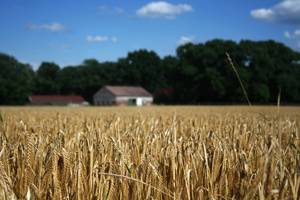Agriculture sector continues to grow in the Iowa economy

Courtesy: Stefanie L.
March 12, 2013
The agricultural sector of Iowa’s economy has been the fastest-growing area since 2002, especially in agricultural production.
David Swenson, an associate scientist in the Department of Economics for the College of Agriculture, published a report on March 9, 2013 comparing economic data from 2002 to 2011, with an emphasis on the agricultural sector.
His data in the report is measurable to the gross domestic product. GDP is the value of a country’s overall output of goods and services at market prices, excluding net income from abroad.
According to Swenson’s report, the agricultural production portion of Iowa’s economy has grown 212 percent, and the agriculture-related manufacturing sector has grown 56 percent within that time span.
Iowa’s entire economy grew 53 percent from 2002 to 2011.
“We are growing faster than other states,” Swenson said. “We have way out-performed the nation in income growth, agriculture-wise.”
Swenson’s report also showed that even though there had been a significant growth in GDP for agricultural production, the number of workers in that sector saw a decrease of 672 jobs.
Agricultural manufacturing did, however, have an increase of 17,071 jobs from 2002 to 2011.
In 2011, 125,889 of Iowa’s 1.97 million jobs were linked to agricultural production, while agriculture-related manufacturing accounted for 78,894 jobs.
From 2002 to 2011, the state of Iowa’s employment grew five percent.
“We are losing a little on labor in agriculture production, there are just less farmers, but more land [is] being farmed; technology does this,” Swenson said. “The bright spot, though, is the value-added side. We are having a strong gain in agricultural related manufacturing.”
Agricultural production includes grain and livestock production while agriculture-related manufacturing includes areas such as fertilizer production, meat and food processing, the production of grain bins and tractor manufacturing.
Swenson attributes much of this growth to more acres in Iowa being farmed, higher grain prices, bigger grain yields, more livestock being raised, an increase in demand worldwide and biofuel expansion. According to Swenson, farm income has more than doubled in the last eight years.
Besides farmers, manufacturers and agricultural suppliers have benefited greatly from the growth financially. From these benefits, companies have reinvested into the College of Agriculture and Life Sciences at Iowa State.
John Lawrence, associate dean for the College of Agriculture and Life Sciences, stated that agricultural companies like Monsanto, Pioneer and Sukup Manufacturing Co. have been reinvesting in the college.
“As farmers have been willing to reinvest in equipment and new technology, new innovations have been made enabling agriculture companies to reinvest us,” Lawrence said.
Monsanto has donated money toward the renovation of Curtiss Hall; Pioneer is paying for a new plant breeder for the college and Sukup has donated money for the building of the new agricultural and biosystems engineering complex.
Lawrence pointed out the success of the agricultural sector in the state has led to a higher demand for agriculture students. The demand has increased enrollment in the College of Agriculture and Life Sciences, which broke its enrollment record set in 1977; it expects to break the 4,000-student mark this coming fall.
“The scope of jobs related to agriculture is very large and very important,” Swenson said. “Yes, there are less farmers, but the total number of jobs linked to agriculture is large.”
















